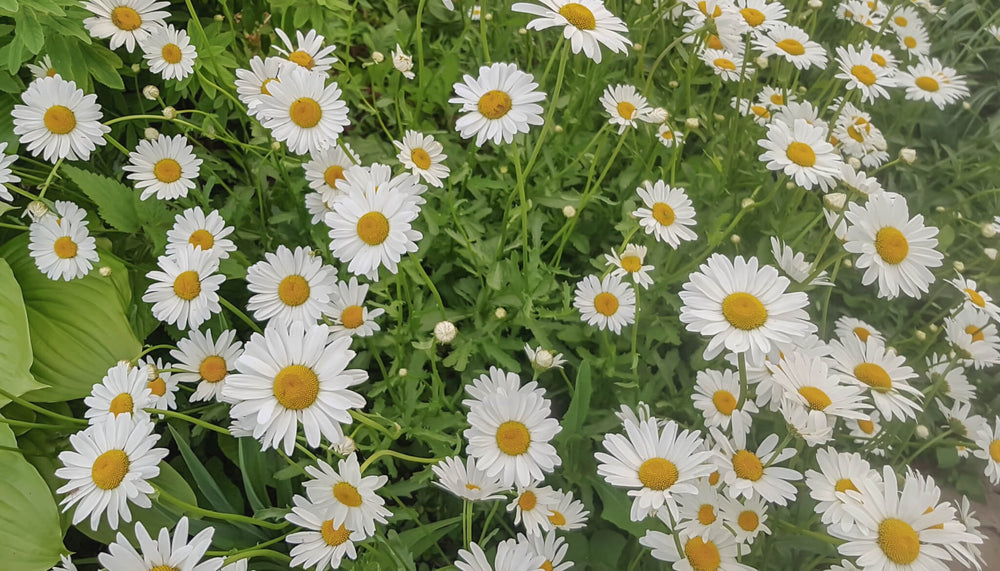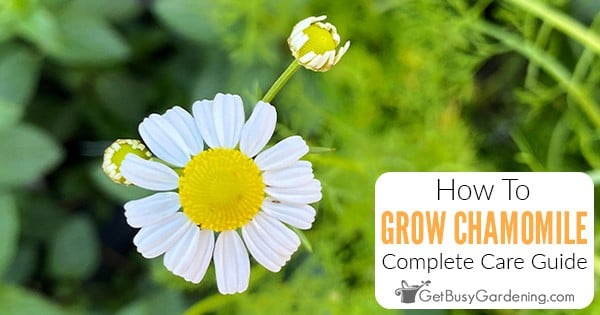

Growing Chamomile at Home -
Spray the seeds and soil with a spray bottle to moisten the medium. You can also use a self-watering pot, bottom water , or moisten the medium before sprinkling the seeds on top. Place the planter in an area of your home that receives direct light for at least six hours per day.
Keep the soil moist with that spray bottle. Once the seedlings emerge, thin them out so there is a maximum of two plants per six-inch pot, or just one plant in any pot smaller than that.
If you opted for a seed tray, thin them to four inches apart. Every year in the spring and summer, you can find chamomile seedlings all over the place at stores. If you pick one up, the process of putting it in a pot is pretty easy.
Put a little of that soil mix described above in a pot that is at least one size up from the container the seedling came in.
Fill in around the plant with more soil and water well to settle it in. Add more soil if you need to. Place the container in a location where it will receive at least six hours of sunlight.
Once established they can go a bit longer between watering, but it should stay moist initially. Chamomile is one of the easier herbs to care for indoors.
The major factor that you need to keep in mind is sunlight. While your indoor basil or cilantro might be fine in a bit less light, chamomile needs full sunlight to produce flowers. Barnyard Pendant LED Grow Light.
Oslo LED Grow Light. Prop the container up on the sloping side as needed so it sits more or less flat. This prevents water from gathering in the far lower edge of the container or from running away from the shallow roots at the top before they can soak up the moisture.
Keep your plant somewhere a bit warmer during the winter, in that case. Make a note in your gardening journal , and set a reminder on your phone. When it goes off, use a mild, all-purpose fertilizer applied according to package directions for container-grown plants.
Down to Earth All Purpose Mix. Arbico Organics carries this product in one-, five-, or pound containers. To divide, pull the plant out of the pot and cut it down the middle through the stems, leaves, roots, and soil. Replant as you would a transplant, in two separate pots.
Leave the container outdoors year-round but winterize the pot by sinking it into the ground or by placing in it in a second, larger pot to create a planting silo.
With the exception of aphids, chamomile is not bothered by any pests or diseases Aphids can be washed off with a garden hose.
Roman chamomile is best propagated by division in the spring just as the new growth starts. Dig up the clump and lift it out of the ground, then cut it into smaller sections.
Make sure each section has intact roots. If you are propagating it from a large mat, you can also cut of a section of the plant with its roots. Replant the sections at the same level as the original plant and water them well until established.
German chamomile is started from seed and in most areas is best started indoors 6 to 8 weeks before the last average frost date. Place the seeds in 4-inch pots filled with damp potting mix.
Do not cover them as they need light to germinate. Keep them at a temperature between 60 to 75 degrees and evenly moist. Once the seedlings emerge, they will need ample sun; place them in a bright, south- or west-facing window or under grow lights and transplant them outdoors after the last danger of frost.
In spring and summer, gather leaves to use fresh or to dry for later use. Pick fully open, fresh flowers early in the day.
Rinse under running water and pat dry. To dry the flowers, spread them on a rack or screen and place in a dry, warm spot but out of direct sunlight. Leave them until fully dried, about 2 weeks.
Store dried flowers in airtight jars in a dark location. Note that due to its side effects, chamomile should only be consumed in limited amounts and with caution.
It should not be consumed by people with asthma and pregnant women. Matricaria recutita is an annual bearing daisy-shape white flowers all summer. It grows 2 feet tall. This is the chamomile widely grown for tea. It has a sweet, straw-like taste with herbal and grassy notes.
Chamaemelum nobile is a potentially evergreen groundcover that grows 3 to 6 to inches tall and spreads 12 inches. Each feathery stem grows one daisy-like flower that is larger than 1 inch in diameter. Zone This cultivar of Roman chamomile is a dwarf non-flowering variety that can be planted instead of lawn.
If forms a 2- to 4-inch tall, fast-growing mat of fern-like fragrant leaves that stays evergreen in areas with mild winters. It does not require clipping. Chamomile spreads over time via creeping stems that root as they move across the soil. German chamomile also freely self-seeds. If you provide chamomile with optimum growing conditions, it can grow aggressively.
To brew a soothing tea, pour hot not boiling water over fresh or dried blooms; steep, strain, and add honey and lemon. You can also trim the stem after the first harvest of flowers. Trimming encourages new growth and more flower production. Harvest fresh flowers as they bloom for use in tea or deadhead faded flowers to encourage new buds.
Propagation methods differ depending on the chamomile type—Roman or German. It's easiest to propagate Roman chamomile by division. German chamomile best reproduces by seed. Both should be propagated in the early spring after the threat of frost is gone.
Dividing Roman chamomile is a good way to keep this rapidly spreading plant from overgrowth. Here's how to propagate Roman chamomile by division :.
German chamomile spreads easily by self-seeding. Start seeds indoors about six weeks before the last expected frost. Chamomile seeds need light to germinate , so scatter them and press them firmly onto the soil, but do not cover the seeds with soil. Water regularly, and they should germinate in seven to 14 days.
Chamomile can grow in any container that is at least 6 inches deep. It requires ample drainage holes, using well-draining, pre-moistened potting soil enriched with fertilizer. If you're transplanting, dig under and around the plant's roots. The best time to transplant chamomile is when the plant is only 2 to 3 inches tall.
Older seedlings do not transplant well. Also, do not transplant the plant in the active flowering phase. Chamomile may survive frost but will not survive freezing. Move potted German chamomile plants indoors in winter to keep them alive in colder climates.
Roman chamomile is a perennial down to zone 4 and can remain outside, but it will need wind protection from harsh, drying winds that can kill Roman chamomile.
Plant it along a wall for a wind break. If potted, wrap the pot with jute to prevent the soil in the pot from freezing. Most insects stay clear of chamomile. Chamomile is used as a cucumber pest deterrent. However, aphids and thrips can sometimes be a problem.
Both can be washed off the plant or treated with insecticidal soap. Chamomile blooms are small with yellow centers and white petals; they look like miniature daisies. The flowers have a sweet, herbaceous aroma, and bloom in the spring and summer. The best way to get your chamomile to bloom is by providing it direct, full sun—it may not bloom if it's shaded.
Other than that, this plant is super-easy: no deadheading or fertilizer needed. Although, deadheading encourages new blooms. Chamomile is an easy-to-grow herb, both inside and out, and experiences very few problems.
But occasionally, it needs a little TLC. This can be a sign of several fungal plant diseases, like botrytis blight. It's remedied by treating your plant with some fungicidal oil. If this happens to your chamomile, it may be getting too much water.
Cut back on the water and see if this makes a difference. The leaves and flowers of the chamomile plant are edible in fresh or dried form.
The stem is not aromatic and is not palatable. Some say it tastes similar to apples, which makes sense because the word chamomile comes from the Greek "kamai-melon," which is loosely translated as "ground apple.
Many people swear Growinf homegrown Growing Chamomile at Home tea Magnesium for weight loss calm their ay. This cheery Seed-tasting events can add Hpme to a Growng and may have sedative qualities. Chamomile growing in the garden is both useful and visually pleasing. There are two kinds of chamomile. The first is Roman chamomile Chamaemelum nobile and the other is German chamomile Matricaria recutita. The Roman variety is the true chamomile but German chamomile is used herbally for nearly the same things. The steps for growing Roman chamomile and growing German chamomile are also nearly identical. Matricaria chamomilla is an annual in Hkme daisy family. Matricaria chamomilla Hkme one Chwmomile several Growing Chamomile at Home species in the daisy Tart cherry juice benefits Asteraceae that have the Gorwing name zt. Growing Chamomile at Home known as German chamomile or wild chamomile, it is one of two species commonly used for making the tisane herbal infusion called chamomile tea. chamomill a syn. Matricaria recutita and Chamomilla recutita is an annual native to southern and eastern Europe and western Asia that has been widely introduced in temperate areas elsewhere where it thrives in disturbed areas, meadows and fields.
Entschuldigen Sie, dass ich Sie unterbreche, aber mir ist es etwas mehr die Informationen notwendig.
Nach meiner Meinung irren Sie sich. Geben Sie wir werden es besprechen.
Von den Schultern weg! Von der Tischdecke der Weg! Jenem ist es besser!
Ist einverstanden, die sehr lustige Meinung